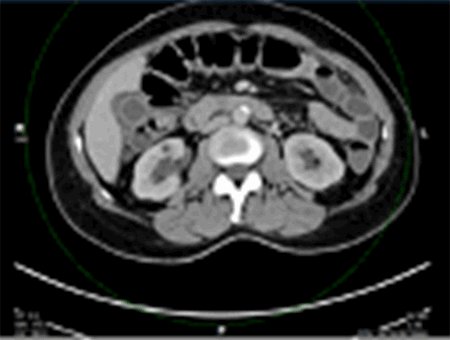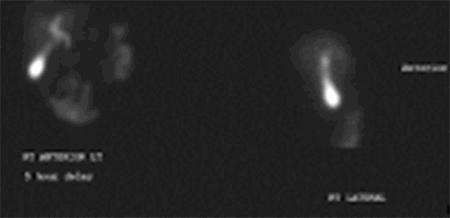Abstract
Background
We present a case of widely metastatic breast cancer at diagnosis, with incidental finding of additional gallbladder metastasis after cholecystectomy for biliary colic.
Summary
Our patient, with known metastatic breast cancer to the spine and lungs, presented to the emergency department with right upper quadrant pain, nausea, and vomiting. Diagnostic workup indicated gallbladder wall thickening but no evidence of cholecystitis or cholelithiasis. The patient continued to have symptoms despite antibiotic therapy. She was taken for diagnostic laparoscopy, which revealed gangrenous, perforated cholecystitis. Laparoscopic cholecystectomy was performed, and the final pathology of the resected gallbladder indicated the presence of metastatic breast carcinoma.
Conclusion
Metastatic breast cancer to the gallbladder is a rare phenomenon. Still, it should be considered in breast cancer patients with right upper quadrant pain even when traditional diagnostic imaging seems negative for acute cholecystitis.
Key Words
metastatic breast cancer; gangrenous cholecystitis
Case Description
Breast cancer is the most frequently diagnosed cancer in women. With modern imaging techniques and screening guidelines, patients are being diagnosed with earlier-stage disease. However, around 20–30 percent of patients will subsequently develop distant metastatic disease.4 In addition, up to 10 percent of patients may present with synchronous metastatic disease.4,8 Breast cancer most often metastasizes to the lymph nodes, lung, bones, liver, and brain.1–4,6–9
Lobular breast cancer is the second most common type of invasive breast cancer, making up 5–15 percent of cases.8 Lobular breast cancer, in particular, has a higher incidence of metastasis to the gastrointestinal tract, peritoneum, and retroperitoneum, most commonly metastasizing to the stomach and small intestine.1,3,4,6–9
Metastasis to the gallbladder from any cancer is rare. An analysis of 1,000 autopsies revealed that only 5.8 percent of all carcinomas had metastases to the gallbladder.2 Gallbladder metastases most often originate from melanoma, renal cell carcinoma, and cervical carcinoma primaries.1,3,5 Gallbladder metastasis from breast cancer specifically is extremely rare, with only 25–30 reported cases in the English literature.1,4,5,7 We present a case of widely metastatic breast cancer at diagnosis, with incidental finding of additional gallbladder metastasis after cholecystectomy for biliary colic.
The patient is a 59-year-old female with a PMH of HTN, HLD, asthma, CVA, and MI, currently undergoing chemotherapy for metastatic breast cancer. Previous workup including PET/CT demonstrated diffuse bone and pulmonary metastasis and a 4.5 cm left breast mass invading the pectoralis muscle along with axillary and internal mammary lymphadenopathy. Of note, the hepatobiliary system was observed to have physiologic FDG distribution with no suspicious masses or biliary ductal dilatation. Image-guided biopsy of a left lung mass revealed a poorly differentiated carcinoma, consistent with breast primary. The tumor cells were strongly positive for GATA3, ER, PR, and HER2/neu (triple positive) and negative for TTFl and P63.
One week after her first cycle of chemotherapy, she presented to our emergency department with complaints of right upper quadrant abdominal pain. She described the pain as a sharp, stabbing in nature that was acute in onset associated with nausea and vomiting. She denies any previous episodes of similar pain. On physical exam, she was afebrile, vital signs were stable, and tenderness in the right upper quadrant was noted. Her white blood cell count was 10,000, and liver function tests revealed an elevated AST, ALT, and alkaline phosphatase. An abdominal CT scan showed marked gallbladder wall thickening without obvious cholelithiasis (Figure 1), while a HIDA scan was negative for cholecystitis with no obstruction of the cystic or common bile duct (Figure 2).
Figure 1. CT Scan Revealing Markedly Thickened Gallbladder Wall with Surrounding Pericholecystic Fluid. Published with Permission



